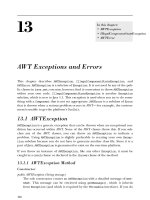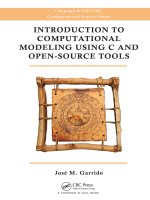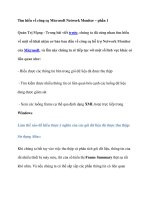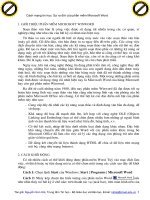INTRODUCTION TO STATISTICS THROUGH RESAMPLING METHODS AND MICROSOFT OFFICE EXCEL phần 1 pot
Bạn đang xem bản rút gọn của tài liệu. Xem và tải ngay bản đầy đủ của tài liệu tại đây (632.77 KB, 25 trang )
INTRODUCTION TO
STATISTICS THROUGH
RESAMPLING METHODS
AND
MICROSOFT
OFFICE EXCEL
®
Phillip I. Good
A JOHN WILEY & SONS, INC., PUBLICATIONINTRODUCTION TO
STATISTICS THROUGH
RESAMPLING METHODS
AND
MICROSOFT
OFFICE EXCEL
®INTRODUCTION TO
STATISTICS THROUGH
RESAMPLING METHODS
AND
MICROSOFT
OFFICE EXCEL
®
Phillip I. Good
A JOHN WILEY & SONS, INC., PUBLICATION
Copyright © 2005 by John Wiley & Sons, Inc. All rights reserved.
Published by John Wiley & Sons, Inc., Hoboken, New Jersey.
Published simultaneously in Canada.
No part of this publication may be reproduced, stored in a retrieval system, or transmitted in
any form or by any means, electronic, mechanical, photocopying, recording, scanning, or
otherwise, except as permitted under Section 107 or 108 of the 1976 United States
Copyright Act, without either the prior written permission of the Publisher, or authorization
through payment of the appropriate per-copy fee to the Copyright Clearance Center, Inc.,
222 Rosewood Drive, Danvers, MA 01923, 978-750-8400, fax 978-646-8600, or on the
web at www.copyright.com. Requests to the Publisher for permission should be addressed
to the Permissions Department, John Wiley & Sons, Inc., 111 River Street, Hoboken, NJ
07030, (201) 748-6011, fax (201) 748-6008.
Limit of Liability/Disclaimer of Warranty: While the publisher and author have used their
best efforts in preparing this book, they make no representations or warranties with respect
to the accuracy or completeness of the contents of this book and specifically disclaim any
implied warranties of merchantability or fitness for a particular purpose. No warranty may be
created or extended by sales representatives or written sales materials. The advice and
strategies contained herein may not be suitable for your situation. You should consult with a
professional where appropriate. Neither the publisher nor author shall be liable for any loss of
profit or any other commercial damages, including but not limited to special, incidental,
consequential, or other damages.
For general information on our other products and services please contact our Customer
Care Department within the U.S. at 877-762-2974, outside the U.S. at 317-572-3993 or
fax 317-572-4002.
Wiley also publishes its books in a variety of electronic formats. Some content that appears in
print, however, may not be available in electronic format.
Library of Congress Cataloging-in-Publication Data:
Good, Phillip L
Introduction to statistics through resampling methods and Microsoft Office Excel /
Phillip I. Good.
p. cm.
Includes bibliographical references and index.
ISBN-13: 978-0-471-73191-7 (acid-free paper)
ISBN-10: 0-471-73191-9 (pbk : acid-free paper)
1. Resampling (Statistics) 2. Microsoft Excel (Computer file) I. Title.
QA278.8.G62 2005
519.5¢4—dc22
2005040801
Printed in the United States of America
10987654321
Preface xi
1. Variation (or What Statistics Is All About) 1
1.1. Variation 1
1.2. Collecting Data 2
1.3. Summarizing Your Data 3
1.3.1 Learning to Use Excel 4
1.4. Reporting Your Results: the Classroom Data 7
1.4.1 Picturing Data 10
1.4.2 Displaying Multiple Variables 10
1.4.3 Percentiles of the Distribution 15
1.5. Types of Data 20
1.5.1 Depicting Categorical Data 21
1.5.2 From Observations to Questions 23
1.6. Measures of Location 23
1.6.1 Which Measure of Location? 25
1.6.2 The Bootstrap 27
1.7. Samples and Populations 30
1.7.1 Drawing a Random Sample 32
1.7.2 Ensuring the Sample is Representative 34
1.8. Variation—Within and Between 34
1.9. Summary and Review 36
2. Probability 39
2.1. Probability 39
2.1.1 Events and Outcomes 41
2.1.2 Venn Diagrams 41
2.2. Binomial 43
2.2.1 Permutations and Rearrangements 45
2.2.2 Back to the Binomial 47
Contents
2.2.3 The Problem Jury 47
2.2.4 Properties of the Binomial 48
2.2.5 Multinomial 52
2.3. Conditional Probability 53
2.3.1 Market Basket Analysis 55
2.3.2 Negative Results 56
2.4. Independence 57
2.5. Applications to Genetics 59
2.6. Summary and Review 60
3. Distributions 63
3.1. Distribution of Values 63
3.1.1 Cumulative Distribution Function 64
3.1.2 Empirical Distribution Function 66
3.2. Discrete Distributions 66
3.3. Poisson: Events Rare in Time and Space 68
3.3.1 Applying the Poisson 69
3.3.2 Comparing Empirical and Theoretical Poisson
Distributions 70
3.4. Continuous Distributions 71
3.4.1 The Exponential Distribution 71
3.4.2 The Normal Distribution 72
3.4.3 Mixtures of Normal Distributions 74
3.5. Properties of Independent Observations 74
3.6. Testing a Hypothesis 76
3.6.1 Analyzing the Experiment 77
3.6.2 Two Types of Errors 80
3.7. Estimating Effect Size 81
3.7.1 Confidence Interval for Difference in Means 82
3.7.2 Are Two Variables Correlated? 84
3.7.3 Using Confidence Intervals to Test Hypotheses 86
3.8. Summary and Review 87
4. Testing Hypotheses 89
4.1. One-Sample Problems 89
4.1.1 Percentile Bootstrap 89
4.1.2 Parametric Bootstrap 90
4.1.3 Student’s t 91
4.2. Comparing Two Samples 93
4.2.1 Comparing Two Poisson Distributions 93
4.2.2 What Should We Measure? 94
vi
CONTENTS
4.2.3 Permutation Monte Carlo 95
4.2.4 Two-Sample t-Test 97
4.3. Which Test Should We Use? 97
4.3.1 p Values and Significance Levels 98
4.3.2 Test Assumptions 98
4.3.3 Robustness 99
4.3.4 Power of a Test Procedure 100
4.3.5 Testing for Correlation 101
4.4. Summary and Review 104
5. Designing an Experiment or Survey 105
5.1. The Hawthorne Effect 106
5.1.1 Crafting an Experiment 106
5.2. Designing an Experiment or Survey 108
5.2.1 Objectives 109
5.2.2 Sample from the Right Population 110
5.2.3 Coping with Variation 112
5.2.4 Matched Pairs 113
5.2.5 The Experimental Unit 114
5.2.6 Formulate Your Hypotheses 114
5.2.7 What Are You Going to Measure? 115
5.2.8 Random Representative Samples 116
5.2.9 Treatment Allocation 117
5.2.10 Choosing a Random Sample 118
5.2.11 Ensuring that Your Observations are
Independent 119
5.3. How Large a Sample? 120
5.3.1 Samples of Fixed Size 121
• Known Distribution 122
• Almost Normal Data 125
• Bootstrap 127
5.3.2 Sequential Sampling 129
• Stein’s Two-Stage Sampling Procedure 129
• Wald Sequential Sampling 129
• Adaptive Sampling 133
5.4. Meta-Analysis 134
5.5. Summary and Review 135
6. Analyzing Complex Experiments 137
6.1. Changes Measured in Percentages 137
6.2. Comparing More Than Two Samples 138
CONTENTS vii
6.2.1 Programming the Multisample Comparison
with Excel 139
6.2.2 What Is the Alternative? 141
6.2.3 Testing for a Dose Response or Other Ordered
Alternative 141
6.3. Equalizing Variances 145
6.4. Stratified Samples 147
6.5. Categorical Data 148
6.5.1 One-Sided Fisher’s Exact Test 150
6.5.2 The Two-Sided Test 151
6.5.3 Multinomial Tables 152
6.5.4 Ordered Categories 153
6.6. Summary and Review 154
7. Developing Models 155
7.1. Models 155
7.1.1 Why Build Models? 156
7.1.2 Caveats 158
7.2. Regression 159
7.2.1 Linear Regression 160
7.3. Fitting a Regression Equation 161
7.3.1 Ordinary Least Squares 162
• Types of Data 166
7.3.2 Least Absolute Deviation Regression 168
7.3.3 Errors-in-Variables Regression 168
7.3.4 Assumptions 171
7.4. Problems with Regression 172
7.4.1 Goodness of fit versus prediction 172
7.4.2 Which Model? 173
7.4.3 Measures of Predictive Success 174
7.4.4 Multivariable Regression 175
7.5. Quantile Regression 182
7.6. Validation 183
7.6.1 Independent Verification 183
7.6.2 Splitting the Sample 184
7.6.3 Cross-Validation with the Bootstrap 185
7.7. Classification and Regression Trees 186
7.8. Data Mining 190
7.9. Summary and Review 193
viii
CONTENTS
8. Reporting Your Findings 195
8.1. What to Report 195
8.2. Text, Table, or Graph? 199
8.3. Summarizing Your Results 200
8.3.1 Center of the Distribution 201
8.3.2 Dispersion 203
8.4. Reporting Analysis Results 204
8.4.1 p Values? Or Confidence Intervals? 205
8.5. Exceptions Are the Real Story 206
8.5.1 Nonresponders 206
8.5.2 The Missing Holes 207
8.5.3 Missing Data 207
8.5.4 Recognize and Report Biases 208
8.6. Summary and Review 209
9. Problem Solving 211
9.1. The Problems 211
9.2. Solving Practical Problems 215
9.2.1 The Data’s Provenance 215
9.2.2 Inspect the Data 216
9.2.3 Validate the Data Collection Methods 217
9.2.4 Formulate Hypotheses 217
9.2.5 Choosing a Statistical Methodology 218
9.2.6 Be Aware of What You Don’t Know 218
9.2.7 Qualify Your Conclusions 218
Appendix: An Microsoft Office Excel Primer 221
Index to Excel and Excel Add-In Functions 227
Subject Index 229
CONTENTS ix
tistical methodology to a wide audience, simply and intuitively, through
resampling from the data at hand.
The resampling methods—permutations and the bootstrap—are easy to
learn and easy to apply. They require no mathematics beyond introductory
high-school algebra, yet are applicable in an exceptionally broad range of
subject areas.
Introduced in the 1930s, the numerous, albeit straightforward calcula-
tions resampling methods require were beyond the capabilities of the
primitive calculators then in use. They were soon displaced by less power-
ful, less accurate approximations that made use of tables. Today, with a
powerful computer on every desktop, resampling methods have resumed
their dominant role and table lookup is an anachronism.
Physicians and physicians in training, nurses and nursing students, busi-
ness persons, business majors, research workers, and students in the bio-
logical and social sciences will find here a practical and easily grasped
guide to descriptive statistics, estimation, testing hypotheses, and model
building.
For advanced students in biology, dentistry, medicine, psychology, soci-
ology, and public health, this text can provide a first course in statistics
and quantitative reasoning.
For mathematics majors, this text will form the first course in statistics,
to be followed by a second course devoted to distribution theory and
asymptotic results.
Hopefully, all readers will find my objectives are the same as theirs: To
use quantitative methods to characterize, review, report on, test, estimate, and
classify findings.
Warning to the autodidact: You can master the material in this text
without the aid of an instructor. But you may not be able to grasp even
Preface
the more elementary concepts without completing the exercises. Whenever
and wherever you encounter an exercise in the text, stop your reading and
complete the exercise before going further.
You’ll need to download and install several add-ins for Excel to do the
exercises, including BoxSampler, Ctree, DDXL, Resampling Statistics for
Excel, and XLStat. All are available in no-charge trial versions. Complete
instructions for doing the installations are provided in Chapter 1. For
those brand new to Excel itself, a primer is included as an Appendix to the
text.
For a one-quarter short course, I’d recommend taking students through
Chapters 1 and 2 and part of Chapter 3. Chapters 3 and 4 would be com-
pleted in the winter quarter along with the start of chapter 5, finishing the
year with Chapters 5, 6, and 7. Chapters 8 and 9 on “Reporting Your
Findings” and “Problem Solving” convert the text into an invaluable pro-
fessional resource.
An Instructor’s Manual is available to qualified instructors and may be
obtained by contacting the Publisher. Please visit
/>statistics/ for instructions on how to request a copy of the manual.
Twenty-eight or more exercises included in each chapter plus dozens of
thought-provoking questions in Chapter 9 will serve the needs of both
classroom and self-study. The discovery method is utilized as often as pos-
sible, and the student and conscientious reader are forced to think their
way to a solution rather than being able to copy the answer or apply a
formula straight out of the text. To reduce the scutwork to a minimum,
the data sets for the exercises may be downloaded from
/>resampling.
If you find this text an easy read, then your gratitude should go to Cliff
Lunneborg for his many corrections and clarifications. I am deeply
indebted to the students in the Introductory Statistics and Resampling
Methods courses that I offer on-line each quarter through the auspices of
statistics.com for their comments and corrections.
Phillip I. Good
Huntington Beach, CA
xii
PREFACE
If there were no variation, if every observation were predictable, a
mere repetition of what had gone before, there would be no need for
statistics.
1.1. VARIATION
We find physics extremely satisfying. In high school, we learned the
formula S = VT, which in symbols relates the distance traveled by an
object to its velocity multiplied by the time spent in traveling. If the
speedometer says 60 miles an hour, then in half an hour you are certain to
travel exactly 30 miles. Except that during our morning commute, the
speed we travel is seldom constant.
In college, we had Boyle’s law, V = KT/P, with its tidy relationship
between the volume V, temperature T, and pressure P of a perfect gas.
This is just one example of the perfection encountered there. The problem
was we could never quite duplicate this (or any other) law in the freshman
physics laboratory. Maybe it was the measuring instruments, our lack of
familiarity with the equipment, or simple measurement error, but we kept
getting different values for the constant K.
By now, we know that variation is the norm. Instead of getting a fixed,
reproducible V to correspond to a specific T and P, one ends up with a
distribution of values instead as a result of errors in measurement. But we
also know that with a large enough sample, the mean and shape of this
distribution are reproducible.
That’s the good news: Make astronomical, physical, or chemical
measurements and the only variation appears to be due to observational
error. But try working with people.
Anyone who has spent any time in a schoolroom, whether as a parent or
as a child, has become aware of the vast differences among individuals.
Chapter 1
Variation (or What
Statistics Is All About)
Introduction to Statistics Through Resampling Methods & Microsoft Office Excel
®
, by Phillip I. Good
Copyright © 2005 John Wiley & Sons, Inc.
Our most distinct memories are of how large the girls were in the third
grade (ever been beat up by a girl?) and the trepidation we felt on the
playground whenever teams were chosen (not right field again!). Much
later, in our college days, we were to discover there were many individuals
capable of devouring larger quantities of alcohol than we could without
noticeable effect, and a few, mostly of other nationalities, whom we could
drink under the table.
Whether or not you imbibe, we’re sure you’ve had the opportunity to
observe the effects of alcohol on others. Some individuals take a single
drink and their nose turns red. Others can’t seem to take just one drink.
The majority of effort in experimental design, the focus of Chapter 5 of
this text, is devoted to finding ways in which this variation from individual
to individual won’t swamp or mask the variation that results from differ-
ences in treatment or approach. It’s probably safe to say that what distin-
guishes statistics from all other branches of applied mathematics is that it
is devoted to characterizing and then accounting for variation.
2 STATISTICS THROUGH RESAMPLING METHODS AND MICROSOFT OFFICE EXCEL
®
SOURCES OF VARIATION
You catch three fish. You heft each one and estimate its weight; you weigh
each one on a pan scale when you get back to dock, and you take them to
a chemistry laboratory and weigh them there. Your two friends on the boat
do exactly the same thing. (All but Mike; the chem professor catches him
and calls campus security. This is known as missing data.)
The 26 weights you’ve recorded (3 ¥ 3 ¥ 3 - 1 when they nabbed Mike)
differ as result of measurement error, observer error, differences among
observers, differences among measuring devices, and differences among
fish.
1.2. COLLECTING DATA
The best way to observe variation is for you, the reader, to collect some
data. But before we make some suggestions, a few words of caution are in
order: 80% of the effort in any study goes into data collection and prepa-
ration for data collection. Any effort you don’t expend goes into cleaning
up the resulting mess.
We constantly receive letters and E-mails asking which statistic we
would use to rescue a misdirected study. There is no magic formula, no
secret procedure known only to PhD statisticians. The operative phrase is
GIGO: Garbage In, Garbage Out. So think carefully before you embark
on your collection effort. Make a list of possible sources of variation and
see whether you can eliminate any that are unrelated to the objectives of
your study. If midway through, you think of a better method—don’t use
it. Any inconsistency in your procedure will only add to the undesired
variation.
Let’s get started. Here are three suggestions. Before continuing with
your reading, follow through on at least one of them or an equivalent idea
of your own, as we will be using the data you collect in the very next
section:
1. Measure the height, circumference, and weight of a dozen humans (or
dogs, or hamsters, or frogs, or crickets).
2. Time some tasks. Record the times of 5–10 individuals over three track
lengths (say 50 meters, 100 meters, and a quarter mile). Because the
participants (or trial subjects) are sure to complain they could have
done much better if only given the opportunity, record at least two
times for each study subject. (Feel free to use frogs, hamsters, or turtles
in place of humans as runners to be timed. Or to replace foot races
with knot tying, bandaging, or putting on or taking off a uniform.)
3. Take a survey. Include at least three questions and survey at least 10
subjects. All your questions should take the form “Do you prefer A to
B? Strongly prefer A, slightly prefer A, indifferent, slightly prefer B,
strongly prefer B.” For example, “Do you prefer Britney Spears to
Jennifer Lopez?” or “Would you prefer spending money on new class-
rooms rather than guns?”
CHAPTER 1 VARIATION (OR WHAT STATISTICS IS ALL ABOUT) 3
SOURCES OF VARIATION
•
Characteristics of the observer(s)
•
Characteristics of the environment in which observations are made
•
Characteristics of the measuring device(s)
•
Characteristics of the subjects or objects observed
Exercise 1.1. Collect data as described above. Before you begin, write down
a complete description of exactly what you intend to measure and how you
plan to make your measurements. Make a list of all potential sources of
variation. When your study is complete, describe what deviations you
had to make from your plan and what additional sources of variation you
encountered.
1.3. SUMMARIZING YOUR DATA
Learning how to adequately summarize one’s data can be a major chal-
lenge. Can it be explained with a single number like the median? The
median is the middle value of the observations you have taken, so that
half of the data have a smaller value and half have a greater value. Take
the observations 1.2, 2.3, 4.0, 3, and 5.1. The observation 3 is the one in
the middle. If we have an even number of observations such as 1.2, 2.3,
3, 3.8, 4.0, and 5.1, then the best one can say is that the median or mid-
point is a number (any number) between 3 and 3.8. Now, a question for
you: What are the median values of the measurements you made?
Hopefully, you’ve already collected data as described in Section 1.2;
otherwise, face it, you are behind. Get out the tape measure and the
scales. If you conducted time trials, use those data instead. Treat the
observations for each of the three distances separately.
If you conducted a survey, we have a bit of a problem. How does one
translate “I would prefer spending money on new classrooms rather than
guns” into a number a computer can add and subtract? There is more one
way to do this, as we’ll discuss in what follows under the heading, “Types
of Data.” For the moment, assign the number 1 to “Strongly prefer class-
rooms,” the number 2 to “Slightly prefer classrooms,” and so on.
1.3.1. Learning to Use Excel
Calculating the value of a statistic is easy enough when we’ve only 1 or 2
observations, but a major pain when we have 10 or more. And as for
drawing graphs—one of the best ways to summarize your data—we’re no
artists. Let the computer do the work.
We’re going to need the help of Excel, a spreadsheet program with
many built-in statistics and graphics functions. We’ll assume that you
already have Microsoft Office Excel installed and have some familiarity
with its use.
1
To enter the observations 1.2, 2.3, 4.0, 3, and 5.1, simply
type these values down the first column starting in the third row. Notice
in Fig. 1.1 that we’ve put a description of the column in the second row.
The first row is reserved for a more lengthy description of the project
should one be required.
In Fig. 1.1, we’ve begun in Row 8 to start the computation of the
median of our data. Here are the steps we went through:
1. Type the first data element (1.2 in this example) in the third row of
the first column.
2. Press the “Enter” key to go to the next row.
4 STATISTICS THROUGH RESAMPLING METHODS AND MICROSOFT OFFICE EXCEL
®
1
If you’re an absolute beginner, we’ve included an Appendix to the text to help you get
started. If you already own and are familiar with some other statistics package or spreadsheet,
feel free to use it instead. The objective of this text is to help you understand and make use
of basic statistics principles. Excel is merely a convenient tool.
3. Repeat steps 1 and 2 until all the data are entered.
4. Use your mouse to depress the = button in the row.
5. Depress the down arrow next to the word SUM and select “More
Functions” from the resultant display (Fig. 1.2).
6. Select “Statistical” from the Function category menu and “Median”
from the Function name menu.
7. Press “OK” or the “Enter” key to learn that the median of the five
numbers we entered is 2.65.
The median of a sample tells us where the center of a set of observa-
tions is, but it provides no information about the variability of our obser-
vations, and variation is what statistics is all about. Pictures tell the story
the best.
In Section 1.4, we’ll consider some data on heights I collected while
teaching sixth-graders mathematics. The one-way strip chart or dotplot
(Fig. 1.3) created with the aid of Data Desk/XL
2
, an Excel add-in, reveals
that the minimum of this particular set of data is approximately 137cm
CHAPTER 1 VARIATION (OR WHAT STATISTICS IS ALL ABOUT) 5
FIGURE 1.1 Using Excel to compute the median of a data set.
2
A trial version may be downloaded from />data_analysis/ddxl/.
6 STATISTICS THROUGH RESAMPLING METHODS AND MICROSOFT OFFICE EXCEL
®
FIGURE 1.2 A partial list of the functions available in Excel.
FIGURE 1.3 One-way strip chart or dotplot.
and the maximum approximtely 167 cm. Each dot in this strip chart corre-
sponds to an observation. Blotches correspond to multiple observations.
The range over which these observations extend is 167–137, or 30.
By the way, DataDesk/XL is just one of a hundred or more programs
that can add in capabilities to Excel. We’ll be using several such add-ins to
carry out the necessary calculations to complete this course.
A weakness of Fig. 1.3 is that it’s hard to tell exactly what the values of
the various percentiles are. A glance at the box and whiskers plot (Fig. 1.4)
created with the aid of XlStat (Addinsoft, 2004),
3
a second Excel add-in,
tells us that the median of the classroom data described in Section 1.4 is
153.5cm, the mean is 151.6 cm, and the interquartile range (the “box”) is
close to 14cm. The minimum and maximum of the sample are located at
the ends of the “whiskers.”
In Section 1.4, you’ll learn how to create these and other graphs.
1.4. REPORTING YOUR RESULTS:
THE CLASSROOM DATA
Imagine you are in the sixth grade and you have just completed measuring
the heights of all your classmates.
Once the pandemonium has subsided, your instructor asks you and your
team to prepare a report summarizing your results.
Actually, you have two sets of results. The first set consists of the mea-
surements you made of you and your team members, reported in centime-
ters, 148.5, 150.0, and 153.0. (Kelly is the shortest, incidentally, and you
are the tallest.) The instructor asks you to report the minimum, the
CHAPTER 1 VARIATION (OR WHAT STATISTICS IS ALL ABOUT) 7
Box plot - Heights of Sixth Graders
153.500151.568
130 150 170
Height in Centimeters
FIGURE 1.4 Box and whiskers plot of classroom data.
3
A trial version may be downloaded from />median, and the maximum height in your group. This part is easy, or at
least it’s easy once you look the terms up in the glossary of your textbook
and discover that minimum means smallest, maximum means largest, and
median is the one in the middle. Conscientiously, you write these defini-
tions down—they could be on a test.
In your group, the minimum height is 148.5 centimeters, the median is
150.0 centimeters, and the maximum is 153.0 centimeters.
Your second assignment is more challenging. The results from all your
classmates have been written on the blackboard—all 22 of them.
141, 156.5, 162, 159, 157, 143.5, 154, 158, 140, 142, 150, 148.5,
138.5, 161, 153, 145, 147, 158.5, 160.5, 167.5, 155, 137
You copy the figures neatly into the first column of an Excel worksheet as
described in the previous section. Next, you brainstorm with your team-
mates. Nothing. Then John speaks up—he’s always interrupting in class.
Shouldn’t we put the heights in order from smallest to largest? “Of
course,” says the teacher, “you should always begin by ordering your
observations.”
You go to the Excel menu bar as shown in Fig. 1.5 and access the
“sort” command from the “data” menu. As a result, your data are now in
sorted in order from smallest to largest:
8
STATISTICS THROUGH RESAMPLING METHODS AND MICROSOFT OFFICE EXCEL
®
FIGURE 1.5 Accessing the sort command.
137.0 138.5 140.0 141.0 142.0 143.5 145.0 147.0 148.5 150.0 153.0
154.0 155.0 156.5 157.0 158.0 158.5 159.0 160.5 161.0 162.0 167.5
“I know what the minimum is,” you say—come to think of it, you are
always blurting out in class, too, “137 millimeters, that’s Tony.”
“The maximum, 167.5, that’s Pedro, he’s tall,” hollers someone from
the back of the room.
As for the median height, the one in the middle is just 153 centimeters
(or is it 154)? What does Excel tell us? As illustrated in Fig. 1.6, we need
to do the following to find out:
1. Put our cursor in the first empty cell after the data; A25 in our
example.
2. Click the = key on the formula menu bar.
3. Select “median” by using the down arrow ᭢ on the formula bar.
CHAPTER 1 VARIATION (OR WHAT STATISTICS IS ALL ABOUT) 9
FIGURE 1.6 Computing the median of the classroom data.
4. Use the cursor to select the data range or enter the data range using
the form shown in Fig. 1.6 as A3:A24.
5. Press OK.
The result 153.5 will appear in cell A25.
Actually, the median could be any number between 153 and 154, but it
is a custom among statisticians, honored by Excel, to report the median as
the value midway between the two middle values, when the number of
observations is even.
1.4.1. Picturing Data
The preceding scenario was a real one. The results reported here, espe-
cially the pandemonium, were obtained by my sixth grade homeroom at
St. John’s Episcopal School in Rancho Santa Marguarite, CA. The
problem of a metric tape measure was solved by building their own from
string and a meter stick.
My students at St. John’s weren’t through with their assignments. It
was important for them to build on and review what they’d learned in the
fifth grade, so I had them draw pictures of their data. Not only is drawing
a picture fun, but pictures and graphs are an essential first step toward
recognizing patterns.
We begin by downloading a trial copy of DataDesk/XL from the
website />downloads/ddxl.cfm. Note the folder to which you downloaded the
program.
To install this add-in, pull down the Excel Tools menu, select “add-ins,”
and then browse the various folders on the hard disk until you locate the
DDXL add-in. Once DDXL is added, a new pull-down menu, labeled
DDXL will appear on the menu bar as shown in Fig. 1.7.
After selecting “Charts and Plots” as depicted in Fig. 1.7, we complete
the Charts and Plots Dialog shown in Fig. 1.8. Note that among the other
possible headings under “Function type” are Box Plot and Histogram.
We click “OK”, and Fig. 1.9 reveals the end result. As a by-product, the
numeric values of various sample statistics are displayed as well as the
dotplot.
Exercise 1.2. Generate a dot plot and a box plot for one of the data sets
you gathered in your initial assignment. Write down the values of the median,
minimum, and maximum that you can infer from the box plot.
1.4.2. Displaying Multiple Variables
I’d read, but didn’t quite believe, that one’s arm span is almost exactly the
same as one’s height. To test this hypothesis, I had my sixth graders get
10
STATISTICS THROUGH RESAMPLING METHODS AND MICROSOFT OFFICE EXCEL
®









